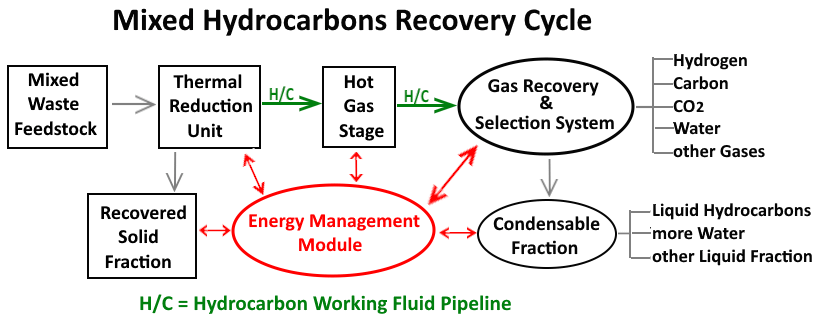
H/C Pipeline Hydrocarbon Splitting CO2 Splitting
Microwave Catalyst Splitting Material Recovery Yields
Mixed Waste to HydroCarbon Pathway NEXT
Flow Cell Implementation Opportunities
Expandable Bladders for Gas Storage

Hydrocarbon Wastes - CO2 Byproduct Valorization
The thermal reduction of
mixed waste
streams that may be converted into recovered carbon and hydrogen commodity feedstocks
is the aim of the Recovery 2.0 process cycle.
In the first of a number of process cycle steps the wastes are thermally converted into a raw biogas fraction and a solids fraction.
The Biogas fraction is then
cleaned
and conditioned in order to produce a intermediate syngas product.
The syngas may be upgraded into segregated Hydrogen and CO2 streams or may be oxy-combusted into a captured and contained
Carbon Dioxide CO2 stream and Waster/Steam fraction.
The CO2 stream may be blended with recovered Hydrogen H2 in a methane synthesis process to produce a stream of
CH4 referred to as Renewable Natural Gas (RNG).
The RNG stream may be sold as an output product or may be used as a feedstock for a Methane Pyrolysis process.
In a Methane Pyrolysis step RNG may be converted into Hydrogen H2 and Solid Recovered Carbon C2.
The Solid
Recovered Carbon
products are a primary output product.
The Hydrogen may be regenerated into the methane synthesis process in order to sequester or fix additional
continuous volumes of CO2 into solid recovered carbon.
Any surplus Hydrogen may be sold as an output product.
Temporary Gas Storage Buffer
An expandable bladder system may be used for temporary storage of low pressure gas and
may act as a flexible buffer between the generation and consumption steps in the Recovery 2.0 process.
Expandable Gas Bags may be designed to fit any dimension in order to take advantage and efficiently fill void spaces.
Forced Collapsible bags may act as a pump to evacuate the gas as and when desired.
Expandable Bladder Gas Storage may be used to accommodate a number of segregated or mixed gases.
Air - Bio Lung
O2 - Oxygen
H2 - Hydrogen
CO2 - Carbon Dioxide
CH4 - RNG Renewable Natural Gas (Methane)
Syngas
mixed gas (H2, CO, CO2)
N Nitrogen -
Ammonia
NH3
Halogens -
Bromine, Chlorine, Fluorine, and Iodine